
 |
|
|
By Simmons B. Buntin Overview  The southern entrance to Rockville Town Square along Maryland Avenue, with Starbucks and Gordon Biersch at street level and apartments (left) and condos (right) above. Photo courtesy Rockville Town Square. Rockville Town Square in Rockville, Maryland, is a 12.5-acre, transit-oriented redevelopment that replaces a failed shopping mall with a vibrant civic, retail, and residential core for the Washington, D.C. inner suburb. Part of a larger town center redevelopment that encompasses the nearby Rockville Metro Plaza (with its Metro Red Line access), the public-private project features a broad town plaza, state-of-the-art library and arts and business innovation center, and pedestrian-oriented shops and restaurants—with condominiums and apartments above. The development also features architecture that incorporates a variety of facades and design elements; a six-story clock tower; an inviting streetscape of wide sidewalks, street furniture, and trees; parking garages utilizing an advanced parking guidance system; and proximity to the Montgomery County Courthouse Historic District and Rockville’s central neighborhoods. Though distinct in its design, Rockville Town Square aims to add to Rockville’s heritage by complementing the mix of existing architecture and street patterns in the redeveloping town center area, expanding Maryland Avenue to create a “main street” adjacent to the public plaza. Additionally, the plaza serves as a focal point and gathering place, hosting a variety of outdoor events, from weekly farmers markets to the annual Rockville Uncorked wine and music festival. Despite opening in the summer of 2007—when national economic decline was quickening—and despite the closing of some Town Square retail since then, particularly some locally-owned restaurants, Rockville Town Square is a success: residential occupancy remains high and shops and restaurants are largely doing well. “We’ve been lucky to never have lingering vacancies in Town Square,” says Cindy Cotte Griffiths of Rockville Central. “Even in this struggling economy, [Rockville Town Square retail developer] Federal Realty Investment Trust brings new businesses into the mix in quick order.” 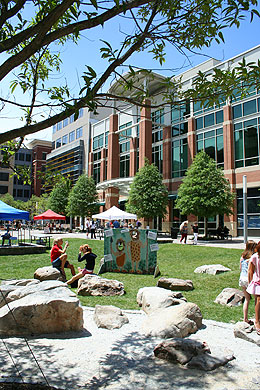 The public plaza with the Rockville Memorial Library and Arts and Innovation Center behind. Photo by Simmons Buntin. In addition to the mix of shops and restaurants, the Rockville Memorial Library, Metropolitan Center for Visual Arts, Rockville Innovation Center, and public plaza with its myriad events continue to draw Rockville residents as well as visitors from across the metro area. “The goal for the city of Rockville is to create a heart and center for Rockville that wasn’t there,” said Rockville chief of redevelopment David Levy at the time of the dedication in July 2007. “It’s a space where people can go and sit outside on a steamy mid-Atlantic summer evening and hang out.” History and Planning Rockville Town Square was enabled through the city’s adoption of the Town Center Master Plan in 2001. The master planning process was led by city planning staff in conjunction with planning consultants Development Concepts, Inc., and infrastructure developers HNTB. But visioning for a redeveloped Rockville town center began well before. A Potomac Almanac article published in conjunction with the Town Square’s dedication notes that “[b]efore construction even started on the town square, debates on what to do with Rockville’s town center had been raging for decades, even preceding the building of the Rockville Mall, the one-story strip mall and parking lot that used to reside where the square now stands.” The mall, which opened in 1972 as part of a city-led urban renewal project, was demolished in 1995, after the city condemned and relocated a number of businesses, reaching settlement agreements with individual property owners. Though the city’s actions were challenged, Rockville’s right to condemn the properties was upheld in court because “the project incorporates true public uses, including four municipal parking facilities, a public square, and a new regional library—fulfilling the requirements of Maryland’s relatively liberal eminent domain statute,” writes commercial real estate legal expert Pamela V. Rothenberg in the Journal of Property Management. To facilitate the project, the city spent nearly $8 million to assist condemned businesses in moving elsewhere, with the goal of having many of the businesses return to Rockville Town Square once complete, as several did. Other challenges faced the city, as well. A gas station site needed reclamation so the property could be designated as “clean,” while the city also worked with the U.S. Army Corps of Engineers to redirect an existing streambed. Removal and reinstallation of utility lines and work on the stream and other portions of the site necessitated the removal of several hundred thousand cubic yards of soil, which was then used as backfill during construction. 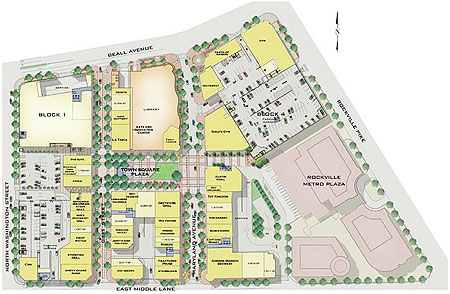 The Rockville Town Center (Rockville Town Square in yellow, Rockville Metro Plaza in mauve) site plan. Click image to view larger version in PDF format. Graphic courtesy City of Rockville. The Town Center Master Plan was created during a nine-month process comprised of stakeholder interviews, Town Center Action Team meetings, feedback from the Greater Rockville Partnership (now Rockville Economic Development, Inc.), public surveys, and a large open house held in September 2000. The open house incorporated four interactive stations to facilitate public discussion and feedback:
At the stations, attendees prioritized previously prepared goal statements. The most critical elements to include in the Town Center, according to the results of this process, were mixed-use development, around-the-clock activity, and a pedestrian-oriented character. Following the September public meeting, the city formed the 24-member Master Plan Advisory Group which was charged with interacting directly with the consultant planning team. The Advisory Group consisted of residents, developers, property owners, business leaders, and representatives from public entities including the city, Montgomery County, Washington Metropolitan Area Transit Authority (Metro), Maryland State Highway Administration, Rockville Chamber of Commerce, and the Greater Rockville Partnership. The Advisory Group created an overarching goal and set of nine objectives that introduce and guide the Town Center Master Plan: Town Center Master Plan Goal Create a daytime, evening, and weekend activity center that is easily identifiable, pedestrian-oriented, and incorporates a mix of uses and activities. Objectives
The Town Center Master Plan focused on Phase I—the area that would become Rockville Town Square plus the adjacent 2.5-acre Rockville Metro Plaza owned by Foulger-Pratt. The Plaza is slated to hold 600,000 square feet of office place; so far, one of three approved office buildings has been constructed. To achieve success in this first phase, the Master Plan also contains an Action Plan that defines 13 tasks—from creating a tax-increment finance district to establishing a tracking system that monitors the area’s mix of uses (see sidebar for full list). The Master Plan provides for zoning changes and creates Design Guidelines for use in a new urban design overlay district. With sections detailing site layout, building scale and massing, fenestration, parking design, and signage, the Design Guidelines hope to achieve seven objectives:
After the Master Plan was approved in October 2001, city staff worked with county, state, and federal agencies to obtain financial commitments for the town center’s first phase—what was to become Rockville Town Square. In total, $360 million was spent in the development of Rockville Town Square over the life of the project: $260 million in private funding and $100 million in public funding, including $60 million total from the city (with $40 million designated for streets, sidewalks, and public parking garages). The county funded the library, at a cost of $26.3 million, and contributed $12 million over six years toward project infrastructure costs. Maryland state government contributed several million more dollars for infrastructure and a public parking garage, and the federal government provided funding for pedestrian improvements. With initial public funding commitments in place, a preliminary development plan based on the Design Guidelines was created. The plan specified elements such as the library and residential, retail, and open space locations, and led to a design competition in June 2002 that was sponsored by the city and Federal Realty Investment Trust—which owned and operated Rockville Mall and partnered with the city on town center redevelopment. The city and Federal Realty Investment Trust selected as their private development partner RD Rockville—a collaboration of Ross Development & Investment and DANAC Corporation of Bethesda, Maryland. A general development agreement was signed by the city, county, RD Rockville, and Federal Realty Investment Trust in January 2003 which provided for construction to begin in 2004. 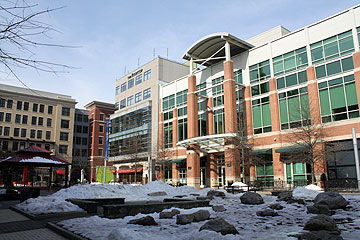 The public plaza in winter, with the library behind. Photo by Simmons Buntin. Private financing for the project began in 2003 with pursuit of an equity partner but ended with RD Rockville taking on “pure debt—consisting of two first mortgages (because the deal was so large) and a mezzanine loan—with . . . five percent of the equity as cash upfront,” according to the Urban Land Institute. In all, private loans of $34 million, $103.2 million, and $73.6 million were secured by RD Rockville before and during construction. Between 2002 and 2004, project planners held more than 40 public meetings. “This persistent effort to educate the community—as well as strong support from the mayor and council—created public support for the project, which many citizens originally opposed,” reports the Urban Land Institute. Town Square architectural design was created by WDG Architecture, with the exception of the library and Arts and Innovation Center. Construction at Rockville Town Square took two and a half years. The project’s grand opening was held in May 2007, followed by a public dedication and retail grand opening in July, when the redevelopment project was praised by Maryland’s governor “as a way to revive the aging suburb,” write Katherine Shaver and Miranda S. Spivack in The Washington Post. The Town Square and Public Events At the heart of Rockville Town Square is a 28,000-square-foot public plaza. The plaza, modeled after the central piazzas of walkable Italian cities, features a pavilion that can serve as a bandstand and lighted stage, a water feature with interactive fountain, sculptures and other public art, a grassy area with rock garden and trees, and wide patios that front the surrounding multistory buildings and pedestrian-oriented streets. The plaza is bordered on the north by the regional library and ground-level shops and restaurants, on the south by ground-level shops and restaurants and multistory residential, and otherwise by streets: Gibbs Street to the west and Maryland Avenue, which serves as a kind of “main street” through the project and fronts Rockville Town Square’s iconic, six-story clock tower, to the east. Shade trees and other plantings, benches, and decorative railings and streetlights line the plaza and streets. In the winter—funding permitting—the plaza hosts an ice rink, as well. 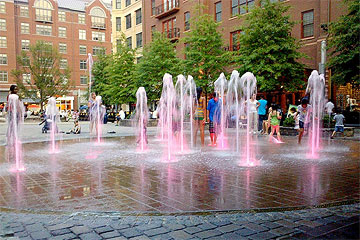 The interactive fountains at Rockville Town Square's public plaza are a big draw, especially in summer. Photo by Brad Rourke, courtesy Rockville Central. The plaza is designed to encourage seating and gatherings, formal and otherwise, and like other successful New Urban developments, fosters chance encounters. “I love the Town Square because I can’t walk more than a couple feet without seeing someone I know from doing business,” says Robin Wiener, according to a 2010 Reuters article profiling Rockville Town Square. Wiener is president of Get Real Consulting, a business located within the town center. The article also notes how “[t]eenagers use Facebook to signal spur-of-the-moment breakdance sessions on the town square’s bandstand because . . . it’s really the only place they can ‘hang out and break.’” One of the reasons Rockville Town Square is considered a success is because of the city’s concerted efforts to bring in regular events and make the project an integrated part of the city. “This is not just any old shopping center,” said Levy at the grand opening. “This is downtown Rockville. It has a history and a past. This is not going to be just a generic place. There will be signature art, historical aspects, and many other events that make it more than just another development.” Those events include a variety of regular activities, such as:
One of the more intriguing events is Rockville Uncorked, the annual festival of wine and music held at Rockville Town Square. A dozen Maryland wineries participate in the late summer event, which in addition to wine tasting also features three stages of local and regional live music, a wine and cooking demonstration stage, and DiVine—
For large events such as Rockville Uncorked, the public pedestrian space of the plaza can be expanded by closing off Gibbs Street and Maryland Avenue, which were specifically designed for periodic closures in support of such gatherings.  The Rockville Memorial Library. Click image for a series of interior and exterior library photos. Photo courtesy Montgomery County Public Library. Library and Arts and Innovation Center If the public plaza is Rockville Town Square’s heart, then its brain is the 102,000-square-foot, $26.3 million regional library, which opened in November 2006. As The Washington Post notes, “The Rockville library has visual showstoppers,” beginning with an exterior wall undulating along the curve of Maryland Avenue. The subtle wave of three-story glass commemorates a significant Rockville occurrence—the mapping of the human genome—and serves as a reference to one-half of the double helix of human DNA. Landscaping along Maryland Avenue completes the other half of the double helix. Rockville Memorial Library was designed by Grimm + Parker Architects, which wanted the library’s signature element to give the building “an appropriate civic presence, as well as a unique physical expression that makes a memorable, inviting impression on visitors to the new Town Center,” according to Montgomery County Public Libraries. The library is also defined by two towers flanking prominent corners. The first anchors the intersection of Maryland Avenue and Beall Avenue, the road along the northern edge of Rockville Town Square. This tower marks the northern gateway to the project and is visible from Rockville Pike—significant because Rockville Town Square is otherwise invisible to motorists along the heavily traveled route. In fact, the Urban Land Institute reports that “it took a summer 2008 water main break that forced the closure of most of Montgomery County’s restaurants—except those in Rockville, which has its own water system—to put Rockville Town Square on the map for many county residents. The project’s restaurants were ‘discovered’ that weekend, and people continue to return to them on a regular basis.” With visibility from primary highways a challenge, the design of the library’s northern tower is critical for enhancing the project’s line-of-sight exposure. The second library tower anchors the building to the plaza, near the library’s main entrance; the ground level of the round tower is actually restaurant space. The library’s entrance is a three-story, glass-roofed portico. The entrance hall features what Grimm + Parker lead architect Melanie Hennigan calls “a wonder wall”—a series of video display terminals with touch screens for accessing the library’s electronic catalog. Beyond that, an open central rotunda features a half-spiral staircase sweeping to the second floor, past a terrazzo mosaic lit by 250 lights suspended from the atrium ceiling—the library’s featured, interior public art, created by Maryland artist Heidi Lippman. 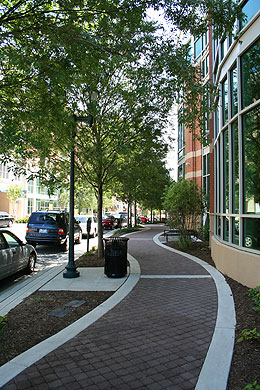 Curved walkway along Maryland Ave. and adjacent to the library reflects the sbutle double helix wave of the building. Photo by Simmons Buntin. The library’s collection includes 200,000 items in print and digital format, special collections such as business and government information, free wifi, two dozen computers accessible from each floor, a children’s room, teen area, popular materials center, disability resource collection, quiet study and group study rooms, tutor rooms, a public meeting room, computer lab, and a world languages area (with a focus on Chinese, Korean, Spanish, Russian, and Vietnamese), which is of particular interest in a region rich in international diversity. The five-story building adjacent to the library hosts the 53,000-square-foot Rockville Arts and Innovation Center, designed by D’Agostino Izzo Quirk Architects. The Center is comprised of the Metropolitan Center for Visual Arts (VisArts) and the Rockville Innovation Center, as well as the Rooftop, a social gathering space and rooftop garden atop the building. VisArts opened in 28,000 square feet of the Center on September 30, 2007, after being housed in temporary space in nearby Gaithersburg while the Town Square was completed. Formerly called Rockville Arts Place, the organization was a permanent resident of the Rockville Mall prior to its demolition. Though a private organization, VisArts partners with the city to offer arts education, exhibitions, professional artist development, and community outreach to the residents of Rockville, Montgomery County, and beyond. Specifically, VisArts offers:
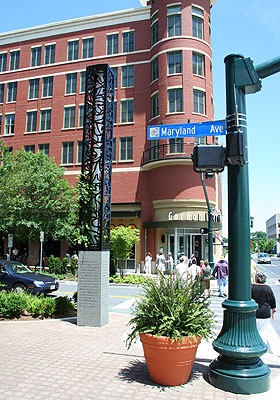 Artwork, retail, and residential at Rockville Town Square's southern entrance. Photo by Simmons Buntin. The Rockville Innovation Center opened in 25,000 square feet of the fourth and fifth floors of the Center in June 2007. It provides space for up to 30 start-up technology companies, with programming provided by Montgomery County’s Business Innovation Network. The Innovation Center’s focus is on domestic technology start-ups in the areas of healthcare, medical, and bioinformatics, as well as international technology companies interested in opening their first U.S. office. The facility provides lease flexibility to tenants, shared amenities such as reception and work and conference rooms, and programs that teach business skills and offer support with licensing, intellectual property, and financing. Companies usually spend two to four years in the Innovation Center before “graduating” and moving to local commercial office space, according to Rockville Economic Development, Inc., which manages the Innovation Center. Commercial Rockville Town Square’s retail and restaurant uses largely comprise the street level of the project’s four mid-rise buildings, including space in the library and Arts and Innovation Center. A total of approximately 180,000 square feet for shops and restaurants is available and mostly filled—the notable exception being the 32,000-square-foot grocery space that anchors the northeast corner of the project. After early negotiations with upscale grocer Harris Teeter fell through, two years of discussions with regional chain Superfresh occurred and subsequently a 20-year lease was signed in 2007. But the contract was canceled in March 2010, and parent company A&P (The Great Atlantic and Pacific Tea Company, Inc.) has since filed for Chapter 11 bankruptcy. The store was originally scheduled to open in November 2007, and is still the only retail space that has never been filled. Hope, however, remains: in December 2010, Federal Realty Investment Trust “shared with the city that they are very close to a lease agreement with a grocery store,” reports Cindy Cotte Griffiths of Rockville Central. The grocery store, which is still on track as of March 2011 but not yet identified, will be the first store of the company’s brand in Maryland. Federal Realty Investment Trust began marketing the retail spaces at least two years before construction concluded. Due to the site’s location—between two large shopping malls also located in Montgomery County—and the history of its own failed mall, however, the developer was not able to attract large, national retailers. The result, reports the Urban Land Institute, is that the project “has more of an entertainment/service base than many town center mixed-used developments,” and while Rockville Town Square has a core of mixed uses, it “probably will not fully mature until the area immediately surrounding it is built out with more office and retail space”—a defined goal of the city and Town Center Master Plan. Starbucks Coffee was the first retail establishment to open, in 2007, at the southwest corner of Maryland Avenue—a primary entrance to the Town Square. Over the next several months, more than 40 other shops and restaurants opened, with a mix of local and national restaurants, boutiques, shops, and services. National and regional chains include Gordon Biersch Brewing Company (anchoring the corner opposite Starbucks), Gold’s Gym, CVS Pharmacy (with its drive-thru in an adjacent parking garage), Five Guys Burgers and Fries, and Capital One Bank. Local stores and services include Toy Kingdom, The Waygoose Gallery of American Crafts (one of the shops located at Rockville Mall before its demolition), and Jouvence Lifestyle Salon and Spa. 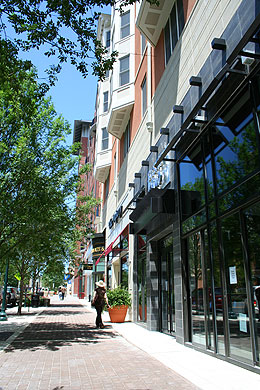 Street-level retail and pedestrian- focused amenities along Maryland Avenue. Photo by Simmons Buntin. As businesses have closed, others have opened. When locally-owned Greystone Grill shut its doors, Buffalo Wild Wings—a national chain—moved in. The Cingular/AT&T Wireless store was replaced by Sands Artwork Gallery, and the original space of New Wave Discount Hair Supply—which moved into the space first occupied by The Papery—is now occupied by Color Me Mine ceramics painting shop. Rockville Town Square business owners are concerned, of course, but not overly so. “When you have a development like Town Square,” says Austin Grill general manager and Rockville Town Square Merchants Association spokesperson Stephen Schadler, “you put in a mix of retail and restaurants that you think will be successful; however, you’re never going to get that perfect fit the first time around. There’s always going to be those businesses even in the best of economic times that are going to struggle and not make it one way or another. The hope is you bring in new merchants so that you can continue trying to get that right mix and give consumers what they’re demanding.” Rockville mayor Susan R. Hoffmann, commenting in a June 2009 issue of The Gazette, agreed: “Based on what I know about the cycle of retail, this is a fairly common shakeout—two years in—that occurs even in the best of times.” One response to bolster business at least for locally owned retailers has been the city’s implementation of a “buy local” campaign, initiated in late 2008. Toy Kingdom owner Carlos Aulestia is pleased with the program and his investment in it. “They are working hard to increase awareness,” he says. “It provides us with good advertising benefits.” The Buy Rockville campaign is championed by the Rockville Chamber of Commerce and overseen by the Coalition to Preserve Rockville Neighborhood Businesses. According to Jeff Miller, president of the Coalition, “For a relatively small contribution, a business can benefit from a $60,000 marketing campaign.” The program is free to join, which gets businesses listed in its directory, but additional benefits such as enhanced pages on the program’s website, participation in a customer loyalty program, and promotion as sponsors at events such as the Rockville Restaurant Week that kicked off in October 2009, require a membership fee. Town Center Action Team president Mark Pierzchala noted in an April 2009 Town Square Summit that while Rockville Town Square “is doing better than most people think,” it had not yet met the vision of all members of the Action Team. “Some of the kinds of retail the Town Center Action Team members have long wanted to see aren’t there,” he said. “That includes a hardware store and a dry goods store. Plus, I think they see too much of a concentration of high-end shops, so I think they would like to see a better mix.” 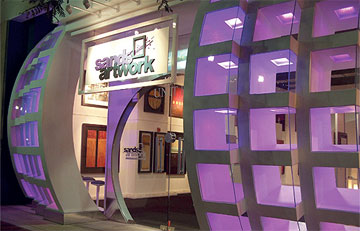 The custom facade and entryway to the Sands Artwork Gallery on Gibbs Street. Photo courtesy Sands Artwork Gallery. In the broader town center context, activity will soon increase, as Choice Hotels will move its corporate headquarters from Silver Spring, Maryland, to Rockville’s town center in order to accommodate 75 more employees (for a total of 475) and a need for 130,000 square feet of office space. The move will take place in 2013, and is likely to include the construction of a Cambria Suites hotel near the headquarters to accommodate an estimated 10,000 stays per year. While the address has not yet been revealed, it is likely to be adjacent to the Town Square because the Rockville town center was selected in part for its proximity to the Rockville Metro station. While the economy has posed challenges for some Rockville Town Square retailers, the design of the streets and building facades have only fostered their success. The buildings incorporate a mix of rooflines, towers and turrets, prominent entryways, detailed brickwork, and canopies and porticos that make the streets and business entries a pleasure to walk through. Restaurant patios extend onto wide sidewalks, fostering an active café and street scene much of the year. Federal Realty Investment Trust paid a fixed price for the retail shells provided by RD Rockville, according to the Urban Land Institute, and then worked with retail tenants to design unique spaces to meet their specific needs. Federal Realty encourages its retail tenants to build out their own storefronts using a set of design guidelines, “to create their own identities, resulting in an eclectic design mix at the street level . . . [a] process that was intended to add to the illusion that the project grew incrementally over time,” reports the Urban Land Institute. The result: nearly 40 different Town Square facades incorporate a mix of finishes, from brick and stone to metal and siding. Residential As early as 2006, residential developer RD Rockville knew that the downturn in the economy could force it to change its strategy of selling all 644 residential units, which range in size from 553-square-foot studios to 2,225-square-foot, three-bedroom + den penthouses originally priced from $300,000 to $900,000. “We’ve gone from a red-hot market to an ice-cold market,” Scott Ross, president of Ross Development, said then, as reported in The New York Times. “Our game plan is to offer some of them for lease if the market continues to be slow.” 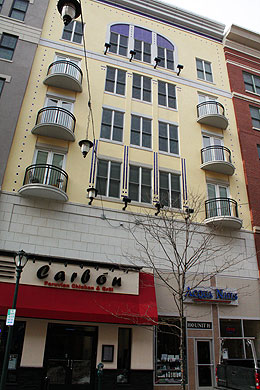 Unique facades of the Fenestra Apartments above street-level shops and restaurants. Photo by Simmons Buntin. The market indeed slowed, even though 30 units sold on the first day and 130 followed over the next two months. In order to accommodate the market shift, however, RD Rockville decided to use only one of four residential buildings for condominiums—now called Palladian Condominiums, with 152 units—while selling the remaining 492 units to a company that could lease them as apartments. RD Rockville sold the remaining units, now called Fenestra Apartments, to CIM Group. The condos are available for purchase and rent-to-own, which allows residents to apply 75 percent of the rent accumulated from the past year toward a down payment on the purchase of the condo, without extra fees or an increase in monthly rent, according to the Palladian Marketing Center. Palladian community amenities include fitness centers, club rooms, pools and sundecks, and high-end entrance lobbies. Condo amenities include hardwood flooring, double-paned windows, controlled access and a reserved parking garage, minimum nine-foot ceilings, high-speed internet and cable TV pre-wiring, gourmet kitchens with granite countertops and maple cabinets, and “luxurious” baths. The Fenestra Apartments feature free community wifi, swimming pool and sun deck, fitness center, club room with billiards, concierge services, controlled building access, and garage parking. Individual apartments—which as of March 2011 rent from $800 to $3,800 per month—offer gourmet kitchens with granite countertops and stainless steel appliances, “luxurious” baths, minimum nine-foot ceilings, hardwood flooring, and largely the same amenities as the Palladian Condominiums. In addition to market-rate condos and apartments, Rockville Town Square has 94 units (15 percent of the total residential number) designated as “moderately priced” under the city’s Moderately Priced Dwelling Unit Program. These units are therefore “affordable to households earning under 60 percent of the area median income.” Though they do not share all of the amenities of the other units—there are no granite countertops, stainless steel appliances, or hardwood flooring, for example—they otherwise are identical to the Palladian condos and Fenestra apartments. All of the residential units are located above street-level retail and the buildings are adjacent to surface parking or parking garages. 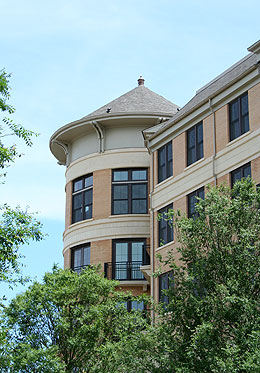 Elements such as turrets at the corners of the multistory buildings of Rockville Town Square help provide a distinct architectural style for the project. Photo courtesy Sands Artwork Gallery. Parking Though not part of the city’s original plans, Rockville Town Square has implemented a $1.5 million parking guidance system, “one of the first applications of this technology outside an airport setting,” according to the Urban Land Institute. The system announces parking space availability, both in number and locations, in the Town Square’s three public garages, and also integrates with payment kiosks within and outside the garages. Secure resident parking is separate from visitor parking. The city owns half of the parking spaces while RD Rockville owns the other half. In total, the Town Square includes approximately 2,000 parking spaces in garages, surface lots, and on-street parking. Though the Town Square is just two blocks from the Rockville Metro station (at Rockville Metro Plaza) a February 2010 article in The Washington Post notes that “merchants said many customers drive there. Suburban shoppers accustomed to free parking have balked at paying for garage parking.” Garage rates have since been reduced and, during the winter holiday season, eliminated entirely in the hopes of bringing in suburban shoppers. Additionally, merchants have handed out fliers at the Shady Grove and Rockville Metro stations, advertising $60-per-month commuter parking in town center garages. “The hope,” the Post article concludes, “is that those commuters might shop or eat on their way to and from work, even if it means they contribute to traffic congestion.” Conclusion Rockville Town Square is the first phase of what the city hopes will be an extensive redevelopment of its town center. As a significant first step—thanks to a comprehensive, stakeholder-involved planning process and a committed development team—the Town Square clearly has established a place in central Rockville where people want to be. Distinctive architecture and streetscapes, a mix of shops and restaurants, state-of-the-art library and arts and business incubation facilities, urban residences, an inviting public plaza, proximity to the Rockville Metro, and an evolving program of events result in a thriving urban core in a suburban setting. Both residents and professional town planners agree: “I wanted a lifestyle where I didn’t have to get in my car all the time, and something with a community feel,” says Daniel Stauffer, a molecular biologist who moved from rural Virginia to Rockville Town Square for his job in Germantown. “I have a tailor, dry cleaner, and breakfast place right outside my door.” 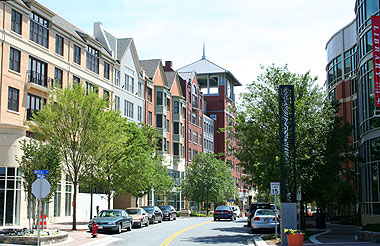 Maryland Avenue viewed from the north, wtih the library on the right and apartments and street-level shops and restaurants, as well as the iconic six-story clock tower, on the left. Photo by Simmons Buntin. Noted town planner and designer Andres Duany is more direct, remarking several months after the project’s grand opening that “[t]he best New Urbanist center, in my opinion, is the brand new Rockville Town Square. Very mature. Very credible as urbanism.” Accordingly, the project won a prestigious Congress for New Urbanism “Neighborhood, District, and Corridor” Charter Award in 2008. The Urban Land Institute reports that the project’s positive impact has been economic, as well: “The area’s property, sales, and income taxes all have risen since Rockville Town Square was completed. As a result, the project’s public sector costs will be pretty much recouped within a decade.” In striving to “create a daytime, evening, and weekend activity center that is easily identifiable, pedestrian-oriented, and incorporates a mix of uses and activities,” as the Town Center Master Plan projected back in 2001, the city of Rockville and its partners have achieved resounding success with Rockville Town Square.
|
|
|||||||||||||||||||||||||||||||||||||||||||||||||||||||||||||||